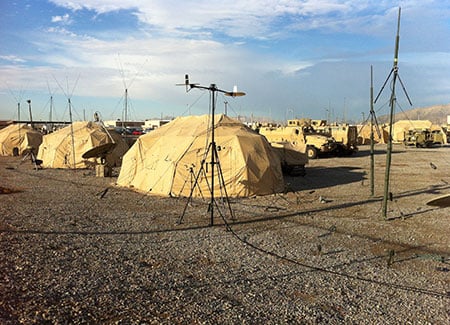
SPECIAL FOCUS AVIATION SUPPORT —By COL Gerald R. Davis Jr.
The dedicated team of over 400 Soldiers, Department of the Army Civilians, and support contractors in the Aviation Systems Project Management Office (AS PMO) are responsible for life-cycle management of both software and hardware that touches every aircraft in the Army Portfolio.
With four product offices responsible for over 50 product lines and $750M annually, the Aviation Systems PMO is critical to Army Aviation operations. We remain committed to our mission of developing and integrating a wide spectrum of world class aviation products and services to meet Soldiers needs, generating common aircraft solutions, and conserving resources.
|
The Aviation Ground Support Equipment (AGSE) product office, led by LTC Steve Ansley, is the life cycle manager for all common AGSE used within Army Aviation and is often referred to as “the Crew Chief’s PM.” AGSE has direct responsibility for every piece of common aviation ground support equipment from the common aviation sets, kits, outfits, and tools to the flight line vehicles, aerial recovery kits, and forward operating base maintenance. During 2013 AGSE continued to field the Standard Aircraft Towing System (SATS) with crew protection and began fielding the Shop Equipment Contact Maintenance (SECM) vehicles. 2014 will continue to be busy as the team finalizes fielding of both the SATS and SECM and begins fielding the Modernized Maintenance Platform and more than 23,000 individual aviation maintainer tool boxes.With the addition of Blue Force Tracker-Aviation (BFT-A), AME added a situational awareness system to its portfolio. BFT-A, also referred to as BFT1, is now in sustainment and the team is moving out on the development of BFT-2. The modernized system will include a new satellite air transceiver with a KGV-72 type 1 encryption device and is designed as a high-capacity, full duplex network upgrade to the legacy system. Installation of BFT-2 will begin in 2015 and when complete the system will be installed on all UH-60L/M, HH-60M, AH-64 D/E, CH-47F, and OH-58 D/F aircraft.The Aviation Mission Equipment (AME) product office, led by LTC Scott Everton, is responsible for the communication, navigation and surveillance (CNS) systems used throughout Army Aviation. The AME communications team works closely with the PM for Airborne Maritime and Fixed (AMF) Station, part of the Program Executive Office (PEO) Command, Control and Communications – Tactical (C3T), to integrate Joint Tactical Radio Systems into Army Aviation platforms, both manned and unmanned. AME is working with AMF to identify a Small Airborne Networking Radio (SANR) capable of delivering Wideband Networking Waveform, Soldier Radio Waveform, and Single Channel Ground and Airborne Radio System (SINCGARS) Waveforms. Once a SANR solution is identified AME will work with AMF to integrate the SANR onto the Apache Guardian, Black Hawk, Chinook, Kiowa Warrior and Gray Eagle platforms.
The Aviation Network and Mission Planning (ANMP) product office, led by Scott Caruso, remains dedicated to their mission of developing and fielding state-of-the-art mission planning, automated logistics, and interoperability tools. The degraded visual environment team, now referred to as Brownout Rotorcraft Enhancement System (BORES), continues to pursue a long-term capability for our aviators to operate more safely in a degraded visual environment.
The PM AS BORES personnel are part of a team pursuing an Army Acquisition Executive (AAE) approved Analysis of Alternatives scheduled for completion by the end of 2014. ANMP remains on path to field the Aviation Data Exploitation Capability (ADEC), the Aircraft Notebook (ACN), and the Aviation Logistics Enterprise-Platform (ALE-P) Family of Systems (FoS). These systems will replace the legacy Standard Army Management Information System (STAMIS) capabilities and enhance and simplify how Army aviation performs maintenance and logistics functions through highly integrated and improved processes, providing an intuitive, modernized user experience.
The PM AS portfolio is rounded out with the Air Traffic Control (ATC) Product Management Office. The ATC product office, led by LTC Mike Rutkowski, is responsible for the life cycle management of all Army tactical and fixed base air traffic control systems, 19 in total, that enable Army aircraft to function in both the National Airspace System and military/joint use airspace around the globe.
2013 was an exciting year for ATC as they begin fielding of the Mobile Tower System (MOTS), a fielding that will continue through 2018. The MOTS is a tactical control tower that provides both critical communications and positive aircraft control at tactical airfields in any terrain. LTC Rutkowski provided an update in the November edition of ARMY AVIATION.
|
|
In addition to these four product offices and their efforts, PM AS is actively involved in the PEO Aviation transition to the Future Airborne Capability Environment (FACE) military core avionics systems software architecture. FACE is designed to reduce cost of supporting the portability and reuse of software components across the Department of Defense (DoD). The FACE architecture will be important going forward in complying with the Army’s PEO Aviation Common Operating Environment (COE), as legacy core avionics systems continue to receive upgrades rather than replacements with next generation avionics systems.
The Improved Data Modem (IDM) team, part of ANMP, is working towards creating a FACE modular avionics environment solution to be complaint with the FACE Technical Standard for FACE, Edition 1.0. The newly modified IDM will be the first PEO Aviation avionics system to comply with the FACE architecture.
The IDM software modification program will allow for a common computing architecture to support portable capability-specific software applications and serve as model across all Army avionics systems within PEO Aviation to achieve FACE compliance. Future IDM software versions will be required to meet the FACE Technical Standard version approved at time of requirements definition.
Last, but certainly not least, PM AS is the PEO Aviation lead for Army Aviation’s participation at the Network Integration Evaluations (NIE) and the critical tasks to improve air-ground interoperability. In that role, we coordinate and execute activities required to support aerial tier network extension missions and air-ground integration missions involving fixed wing, rotary wing and unmanned aircraft as well as a variety of emerging technologies and waveforms.
The NIE is designed to synchronize the efforts of the requirements, development and test communities to define our future tactical communication needs and speed delivery of integrated network capabilities to our Soldiers in the field. In November 2013 Aviation completed NIE 14.1; 14.2 is scheduled for summer 2014 and planning is already ongoing for 15.1, 15.2, and beyond.
The PM Aviation Systems team remains committed to achieving acquisition excellence while reducing costs. We continue to leverage the power of integration, linking new and legacy systems to reduce Soldier workload and increase combat capabilities.
COL Gerald R. Davis Jr. is the project manager of the Aviation Systems Project Management Office at Redstone Arsenal, AL























